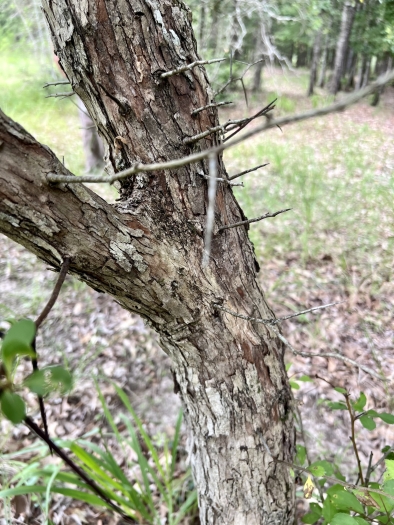Texas Hawthorn
(Crataegus texana)
Texas Hawthorn (Crataegus texana)
/
/

© Laura Clark
CC BY 4.0
Image By:
© Laura Clark
Recorded By:
Copyright:
CC BY 4.0
Copyright Notice:
Photo by: © Laura Clark | License Type: CC BY 4.0 | License URL: http://creativecommons.org/licenses/by/4.0/ | Uploader: lauramorganclark | Publisher: iNaturalist |





























Estimated Native Range
Summary
Crataegus texana, commonly known as Texas Hawthorn, is a deciduous small tree or large shrub that is part of the rose family. It typically blooms in early spring, usually in March and April, showcasing clusters of white flowers that are followed by small, one-inch, scarlet fruits resembling tiny red apples. The fruits are not only ornamental but also edible. The tree’s twigs are armed with thorns that can grow to about one to three inches long, which can make handling the plant challenging. Texas Hawthorn is native to the United States, specifically to the Gulf Prairies and marshes, Post Oak Savannah, and Rio Grande Plains of Texas. It is often found in rich bottomlands and river bottoms, thriving in rich sandy clay loams and bottomland soils near intermittent water sources. It can also be found in fencerows and areas with heavy deciduous shrub and vine growth.
Texas Hawthorn is valued for its moderate growth rate, heat tolerance, and modest water needs. It grows well in areas with partial sunlight and has adaptable soil requirements, making it a versatile choice for gardeners. It reaches about 25 feet in height and is known for its ecological benefits, providing food for birds and mammals during winter. The tree is of special value to native bees, attracting large numbers of them with its flowers. In cultivation, it is used for wildlife gardens, as a specimen plant, or in naturalized areas. The edible fruits can be cooked into jams and jellies, and the plant can also be distilled into liquors. However, gardeners should be cautious of its thorns when planting in areas frequented by people or pets.CC BY-SA 4.0
Texas Hawthorn is valued for its moderate growth rate, heat tolerance, and modest water needs. It grows well in areas with partial sunlight and has adaptable soil requirements, making it a versatile choice for gardeners. It reaches about 25 feet in height and is known for its ecological benefits, providing food for birds and mammals during winter. The tree is of special value to native bees, attracting large numbers of them with its flowers. In cultivation, it is used for wildlife gardens, as a specimen plant, or in naturalized areas. The edible fruits can be cooked into jams and jellies, and the plant can also be distilled into liquors. However, gardeners should be cautious of its thorns when planting in areas frequented by people or pets.CC BY-SA 4.0
Plant Description
- Plant Type: Shrub, Tree
- Height: 15-25 feet
- Width: 15-25 feet
- Growth Rate: Moderate
- Flower Color: White
- Flowering Season: Spring
- Leaf Retention: Deciduous
Growth Requirements
- Sun: Full Sun, Part Shade
- Water: Medium
- Drainage: Medium
Common Uses
Bee Garden, Bird Garden, Border Plant, Low Maintenance, Showy Flowers
Natural Habitat
Native to the Gulf Prairies and marshes, Post Oak Savannah, and Rio Grande Plains of Texas
Other Names
Common Names: Red Hawthorn, Scarlet Hawthorn
Scientific Names: , Crataegus texana, Crataegus dallasiana, Crataegus dasyphylla, Crataegus mollis var. texana, Crataegus texana var. dasyphylla, Phaenopyrum subvillosum,
GBIF Accepted Name: